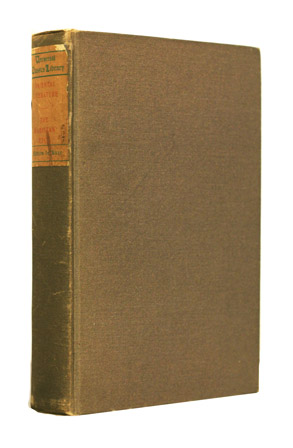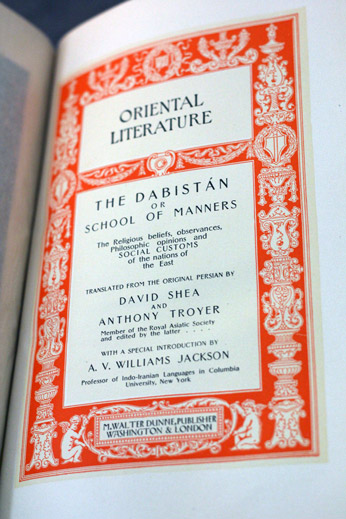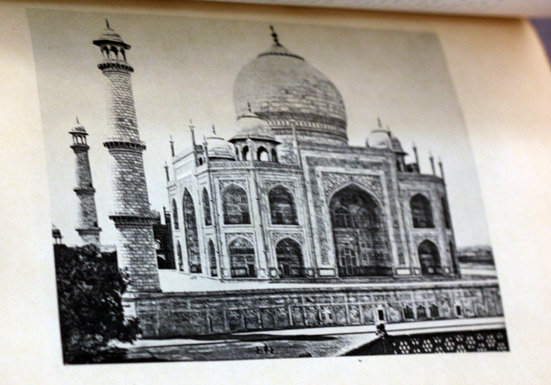Title: The Dabistan or School of Manners: The Religious Beliefs, Observances, Philosophic Opinions and Social Customs of the Nations of the East, Translated from the Original Persian
Author: Unknown. David Shea and Anthony Troyer (trans).
Publisher: Walter J Dunne, 1901.
Condition: Hardcover, plain green cloth. Uncut pages. In very good condition for its age. Firmly bound, general wear throughout.
The Dabistan is a study of the religions practiced in South Asia in the seventeenth century. The editors of this text, the first complete English translation, attribute it to Mohsan Fari, a Kasmiri sufi. Modern scholarship suggests the Persian zoroastrian, Kay Khosrow Esfandiyar, was the true author.
Sir William Jones first drew the attention of Orientalists to the Dabistan after reading it in 1787. The first chapter was translated by Francis Gladwin and first published in Calcutta in 1789.
Constantly quoted throughout the Middle East, and widely read ever since, the Dabistan gives an excellent insight into what Sufis of the time gave out as their teaching, and what scholars and others thought of them. It well vindicates its prefatory phrase: ‘containing what has been reported by those who know what is manifest, and see what is concealed; as well as those who are attached to exterior forms, and by those who discern the inward meaning… without hatred, enmity and scorn, and without taking a part for the one, or against the other side of the question’.
More details (from the Sikh Encyclopedia):
Dabistān-i Mazāhib (Persian: دبستان مذاهب), a seventeenth century work in Persian, is a unique study of different religious creeds and systems of South Asia, including early Sikhism. It first attracted wide notice when it was translated into English by David Shea and Anthony Troyer and was published by Oriental Translation Fund of Great Britain and Ireland, London, in 1843.
There has been a good deal of controversy about the authorship of Dabistān-i Mazāhib. The writer himself has nowhere in the book mentioned his name, parentage or date of birth. Earlier, Mohsini Fani Kashmiri was commonly known to be the author of the book, but the work is now attributed by scholars to an Iranian named Maubad Zulfiqar Ardastani (1615 c. 70). Maubad was a general term for a member or leader of the priestly order of the Zoroastrians.
Zulfiqar grew up under the care of Maubad Hushiyar, himself a disciple of Azhar Kaiwan (d. 1627), the high priest of the Zoroastrians, who had come from Iran to India in the time of Emperor Akbar (1542-1605) and made Patna his second home. Zulfiqar was a religious minded youth with a liberal outlook. He devoted himself to the comparative study of religions and travelled extensively to this end, visiting farflung places such as Gujarat, Hyderabad (1053-59 AH / AD 1643-49), Onssa and Coromandal Coast (1061-63 AH / AD 1651-53). He also spent many years in Kashmir and Lahore (1040-52 AH / AD 1631-42).
Returning to Patna, he settled down in the sector now known as Gulzarbagh. There he started compiling from his notes the book which has become famous as Dabistani Mazahib. A manuscript of the work was discovered by Professor Syed Hasan Askari in the city in the 1930`s in the family of an Iranian Muslim who in his scribbles on the flyleaf (now lost) and in critical marginal notes on certain pages (still preserved) furnished valuable information about the author which was not available to Shea and Troyer. The Dabistan (lit. school) is divided into 12 main sections dealing with Islam, Christianity, Judaism, Hinduism, Sufis, Kabirpanthis, Nanakpanthis and different sects of Zoroastrianism.
The account of Sikhism in this work, given under the title “Nanak Panthiari,” is the earliest from the pen of a non Sikh contemporary writer. Despite certain errors of fact that have crept into it, it is impartial and sympathetic in tone.
Contents:
Special Introduction —
Translator’s Preface —
Invocation —
Cult of the Parsees —
Millenniums of the Lordly Stars —
The Worship Rendered to the Seven Planets —
Against Animal Slaughter —
Scientific Asceticism —
Stopping the Breath —
Stages of Exaltation —
The Sipasian Sect —
The Holy Azar Kaiván —
Disrobing the Spirit —
Stories of Disciples —
Miracle Workers —
The Code of Mahabad —
The Great Angels of the First Order —
The Gradations of Paradise —
The Infernal Regions —
What a King Should Be —
City Government —
The Harem —
Sports and Battles —
Law and Justice —
The Jamshaspian Sect —
The Samradian Sect —
The Khodaiyan Sect —
The Radian Sect —
The Shidrangian Sect —
The Paikarian Sect —
The Sect of Alar —
The Shidabian Sect —
The Akhshiyan Sect —
Incestuous Marriages —
Zoroastrianism —
Influence of the Cow on Zoroaster’s Birth —
His Miraculous Infancy —
Demons and Miracles —
The Precepts of Zardusht —
Viráf’s Excursions through Heaven and Hell —
The Hundred Gates of Paradise —
The Orthodox Hindu System —
Summary of the Budah Mimansa Doctrines —
Concerning the Creation —
Physique of the Deity —
The Mystical Avatars —
Celestial Wives —
Promotions in Paradise —
The Stars Personified —
The Mystery of Time —
Observances of the Smartas —
Curious Brahman Rites —
Marriage Customs —
The Sattee’s Compensation —
Sacrificial Offerings —
The Proprieties —
The Vedantian Sect —
The State of Mukt —
Dreams —
Fakirs and Yogis —
The Sankhya Sect —
Doctrines of the Yogis —
Eating and Breathing —
Holding the Breath —
Strange Customs of the Saktians —
The Illustrious Shaikh Abu Ali Hussain —
The Vichnian Sect —
The Vairagis Sect —
The Creed of the Charvak —
The Doctrine of Tark —
The Buddhists —
The Mahatmas —
The Nânac Sect —
The Story of Janaka —
The Tabitian Sect —
The Yahuds (Jews) —
The Book of Adam —
The Aisuyans (Christians) —
The Muhammedans —
An Account of the Angels —
The Sonnites —
The Shiahs —
A Surah from the Koran —
The Ismailiah —
Omar Khayám —
The Vahadiah —
The Roshenians —
The Ilaliahs —
Dispute of the People of Different Religions —
Christianity Discussed —
The Great Jenghis Khan —
The Religion of the Philosophers —
The Future Life —
An Account of the Pages of Human Actions and Their Recorders —
The Last Judgment —
Account of the Tree Tuba, Which Is in Heaven, and the Tree Zakum, Which Is in Hell —
Of the Reputation and the Truth of the Prophetic Dignity —
The Meaning of Revelation and Inspiration —
The Interpretation of the Miracles of the Prophet —
His Visit to Heaven.






